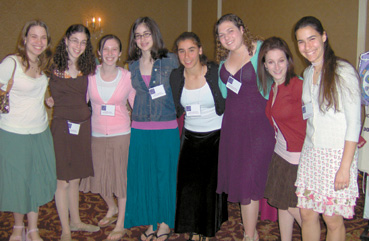Hundreds attend Women’s Seder
Published April 10, 2006
It wasn’t a room full of Reform Jewish women. It wasn’t a room full of Conservative Jewish women. It wasn’t a room full of Orthodox, Traditional and Reconstructionist Jewish women. It was a room filled with St. Louis Jewish women of all ages and you could almost touch the energy they generated. Nishmah’s first annual Women’s Seder Experience met and exceeded the expectations and dreams of planners and participants alike.
“We thought we would sell out at 350,” said Karen Sher, president of Nishmah. Three weeks prior to the program they had 450 reservations. The committee made the decision to reconfigure the event to accommodate as many people as possible in the ballroom at the Crowne Plaza in Clayton. Buffet tables were placed outside the room in the reception areas and the marketplace shopping was moved to another meeting space entirely. Said Sher, “In the end we could not fit in even one more table.” The ballroom holds 500 people which still left 50-60 people on the waiting list.
Ritual co-chair Carol Rubin opened the event which was especially touching for the participants since her father Rabbi Alvan Rubin had just died. In her remarks she talked about erasing the separations between the women and building on the power they have as a community. Singer, songwriter Debbie Friedman also shared that same message as she led the women in song and dance throughout the evening. Though at times, it was the women who were leading Friedman. Said Sher, “There was an intense connection between the women and Debbie. Even she noticed it.”
The room was filled with generations of Jewish women: young girls, teenage girls, college age, young married women, single women, middle age and seniors. They brought their children, sisters, granddaughters, mothers, friends and cousins. Women were singing, dancing and playing the tambourines provided at the tables. Participant Edie Sobel felt a real sense of togetherness and community among the women. “It was a wonderful feeling, said Sobel. “I couldn’t believe how many people were there.”
Crown Center program director Arlene Citerman attended the event with ten residents from the center. “The women were really enthusiastic,” Citerman said. “What was most rewarding for me was helping one of our ladies who is blind join in the dancing. On the bus home, several women commented on how nice the event was and how nice it was to see younger girls present. One woman said, ‘there’s the future of Judaism.'”
In a time when many organizations are having difficulties getting people to be part of boards, the success of the women’s seder is especially telling. The planning committees pulled together a diverse group of women from throughout the St. Louis Jewish community. Said Nishmah executive director Ronit Sherwin, “A big part of the success was the community process. There were no figureheads involved. The key really was the women involved in the process. When something was delegated, they took it and ran with it and took ownership of it. This was really a grass roots effort. The event was reflective of what happens when you invest people in the process in a meaningful way.”
For Sherwin, the event itself spoke volumes about what the women of all ages in the community are looking for and what they have to say. “It didn’t just touch people’s lives for the moment. I think it really inspired women of the potential that could be in the community in terms of creating opportunities,” Sherwin said.
“We wanted this event to represent the entire Jewish community,” said Sher. “If every woman realized the power they have we could move this world.”
Friedman expressed her own thoughts on the extraordinary event in an e-mail she sent to event co-chair Eunice Reichman. Friedman wrote, “I could write adjectives all day describing the experience, but what you must understand is that you created it and allowed yourselves to have it. It was truly inspirational and fun and wonderful.”















